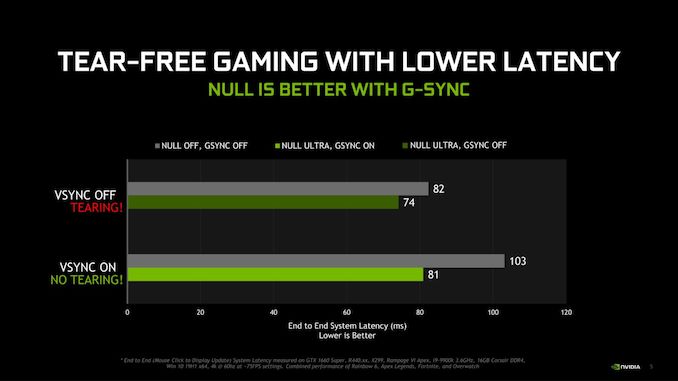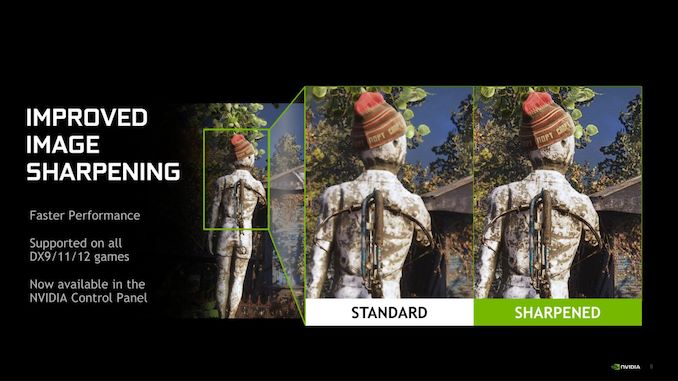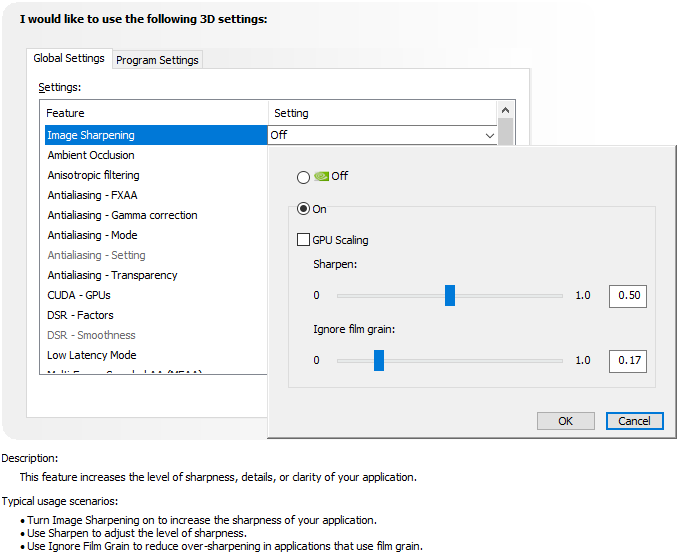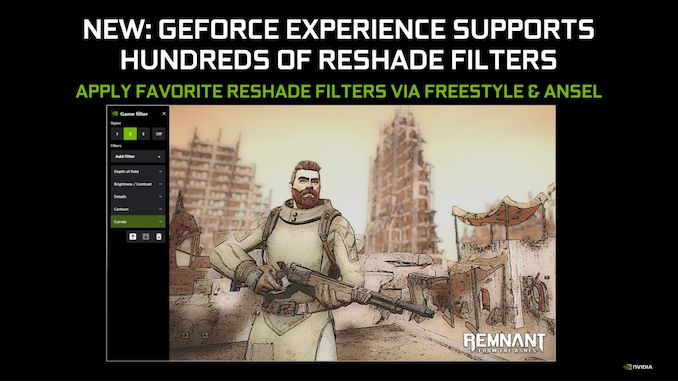The NVIDIA GeForce GTX 1660 Super Review, Feat. EVGA SC Ultra: Recalibrating The Mainstream Market
by Ryan Smith on October 29, 2019 9:00 AM ESTNVIDIA Updates Low-Latency Mode, Adds Reshade Filter Support & Image Sharpening Becomes a Driver Feature
While not a feature specifically limited to or being introduced particularly introduced for the GeForce GTX 1660 Super series, with their driver shipping out today (441.07), NVIDIA is also releasing some new driver features for all of their recent cards, which should be of interest to gamers interested in controlling latency as well as those interested in post-process filtering.
First off, NVIDIA is updating their ultra-low latency mode to better support G-Sync. This feature was first introduced into the NVIDIA driver stack earlier this year, and at the time it wasn’t designed to take into account variable refresh displays. Specifically, it left G-Sync users stock between taking tearing with V-sync off, or taking higher latencies with V-sync on. So, starting with NVIDIA’s newest drivers, it can be better combined with G-Sync, allowing the variable refresh aspects of G-Sync to be used in low latency mode to still keep latency to a minimum, all the while v-sync is kept on to avoid tearing.
The numbers being distributed by NVIDIA show that the latency with G-Sync + ULL + V-Sync on are comparable to that of V-sync off without G-Sync or ULL turned on, so this essentially allows variable refresh and v-sync to be turned on with no latency penalty, or cutting it down significantly from where it was before.
Meanwhile, NVIDIA is also making a couple of image post-processing filter-related changes for their new drivers. Their image sharpening post-process filter, which was introduced a few months ago as part of the Freestyle filter system, has now been promoted to a driver feature. This means that the image sharpening filter no longer requires Freestyle/GeForce experience to use, and, according to NVIDIA, it now works with all DirectX 9, 11, and 12 games, with plans to add OpenGL and Vulkan support soon.
Overall, the control panel-based version of the filter is very similar to the freestyle version of the filter, with adjustments for how strong the sharpening effect is. New to the driver version is the option to allow GPU-upscaling – with the driver upscaling any sub-native resolution to the display’s native resolution – with NVIDIA stating that Turing GPUs will also get a 5-tap filter on top of the usual bilinear upscaling. NVIDIA reports that this new version is also faster than the Freestyle version, though they haven’t listed any specific numbers.
Finally, for even more post-processing options with Freestyle (and Ansel), NVIDIA is adding support for 3rd party ReShade filters. Originally developed as an injector system for adding post-process filters to games – essentially another form of graphics modding – ReShade has been around for several years now. With similar goals as NVIDIA’s own Freestyle system, the company has decided to build in support for ReShader filters to Freestyle, allowing users to enable the filters at a driver level rather than injecting them into running games.
It should be noted, however, that while the basics of ReShade are easy to grasp, the fine print on conditional support is rather extensive. In short, NVIDIA is limiting support for ReShade filters on certain “competitive” games, presumably for cheating/fairness reasons. In the case of those games, only certain official ReShade filters (~30 in all) can be used, and custom filters cannot be used at all. Otherwise, all official and custom filters can be used in non-competitive games.
The Test
As is usually the case for launches without reference hardware, we’ve had to dial down our EVGA card slightly to meet NVIDIA’s reference specifications. So, along with testing it in its as-shipped configuration, it has also been tested with the GPU underclocked by 45MHz, bringing the clockspeeds in line with the reference specs. It’s these values we’re using for our generic GTX 1660 Super results as well as overall performance commentary.
Meanwhile on the driver front, we’re using the latest drivers from both NVIDIA and AMD for their cards. For NVIDIA cards, this is 441.07, and for AMD cards it’s AMD’s Radeon Software 19.10.2.
| CPU: | Intel Core i9-9900K @ 5.0GHz |
| Motherboard: | ASRock Z390 Taichi |
| Power Supply: | Corsair AX1200i |
| Hard Disk: | Phison E12 PCIe NVMe SSD (960GB) |
| Memory: | G.Skill Trident Z RGB DDR4-3600 2 x 16GB (17-18-18-38) |
| Case: | NZXT Phantom 630 Windowed Edition |
| Monitor: | Asus PQ321 |
| Video Cards: | AMD Radeon RX 5700 AMD Radeon RX 590 AMD Radeon RX 580 AMD Radeon R9 380 NVIDIA GeForce RTX 2060 Founders Edition NVIDIA GeForce GTX 1660 Ti EVGA GeForce GTX 1660 Super SC Ultra NVIDIA GeForce GTX 1660 NVIDIA GeForce GTX 1060 6GB Founders Edition NVIDIA GeForce GTX 1060 3GB NVIDIA GeForce GTX 960 |
| Video Drivers: | NVIDIA Release 441.07 AMD Radeon Software Adrenalin 2019 Edition 19.10.2 |
| OS: | Windows 10 Pro (1903) |















65 Comments
View All Comments
dromoxen - Friday, November 8, 2019 - link
MAkes you wonder what NV will do for a GTX1660ti Soupa, maybe faster gddr6 and have 8gb of it? or a half assed RT cores added *clsmithj - Tuesday, October 29, 2019 - link
I'd argue the 1660Ti is still the better choice, it's a full TU116 with the most CUDAs and it's GDDR6 memory has only factory underclocked to run at 12000MHz for 288GB/s, you can easily overclock it to 13000MHz and remove the underclock and get the 336GB/s speed. With my Aorus version, I can easily push it to 13336Mhz for 352GB/s bandwidth.The GTX 1660 Ti is essentially equal to the GTX 1070 Ti.
The_Assimilator - Wednesday, October 30, 2019 - link
"The GTX 1660 Ti is essentially equal to the GTX 1070 Ti."HAHAHA keep smoking the good stuff.
Spunjji - Wednesday, October 30, 2019 - link
Not sure why the snark - he's correct, an overclocked 1660Ti is roughly equivalent to a stock 1070Ti:https://www.guru3d.com/articles_pages/msi_geforce_...
Of course the 1070Ti owner can probably squeeze a little more out of that card too, but that's not really the point.
Flunk - Friday, November 1, 2019 - link
Comparing stock to overclocked doesn't make sense, if they're both overclocked the 1070 ti takes it.TheSkullCaveIsADarkPlace - Saturday, November 2, 2019 - link
Hogwash! The GTX 1660 Ti is clearly a bit faster than a GTX 1070 Ti. I don't have a reference or numbers at hand, but i am confident that an underclocked 1070 Ti will have somwhat lower performance compared to an overclocked 1660 Ti.Sure, the 1660 Ti owner could also underclock its card (if possible in a similar manner as with 10-series cards). But hey, that's not really the point.
flyingpants265 - Wednesday, October 30, 2019 - link
It's another waste-of-time card. What we really needed is an AMD 5600XT for $199. Or something like that. Performing like a 2060, for much less.Ourchasing a 1080p card now is kind of ridiculous, also.
JoeyJoJo123 - Wednesday, October 30, 2019 - link
Why would purchasing a "1080p card" be ridiculous? What qualifies as a 1080p card? Because it's cheap? Because it's "last gen"?https://www.youtube.com/watch?v=HyonSgZiwsE
You know any 3 year old GPU can do 4K gaming after some settings tweaks, all that really matters is that it's a relatively recent (within 2 or 3 gens old) and that it's got a ~4GB framebuffer. I'm not really here to diss anyone's budget. If someone's got to make a $500 PC tower budget work, then a $100 used GPU or a "1080p card" seems pretty sensible.
Xyler94 - Thursday, October 31, 2019 - link
A "1080p" card usually refers to any graphics card that can easily handle 1080p, but struggles with 1440p. Now this assumes high detail of course. You can play 1440p low, or 1080p high, it's your choice really, but I'd rather not have to resort to low settings just to bump my resolution. because what's the point? You gain pixels, but lose detail, which is what pixel gains are supposed to show off...Oliseo - Friday, November 1, 2019 - link
Or you could play 1440 on medium-highIt's nonsense to claim you have to go straight to low going from 1080 to 1440.
As the data in the graphs in the article CLEARLY show.
Try reading the article.